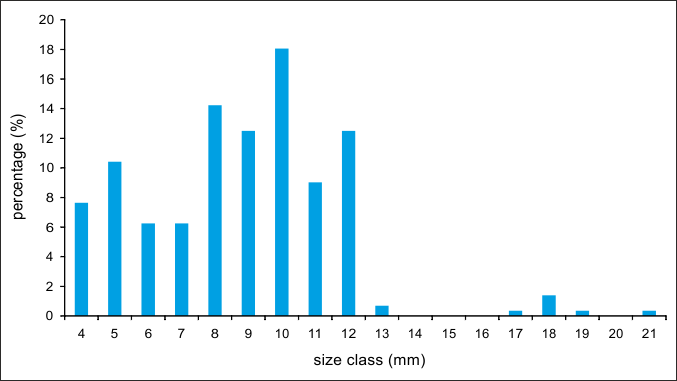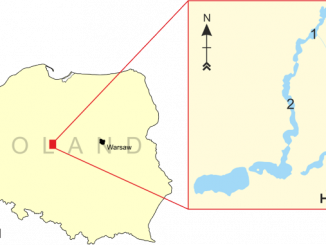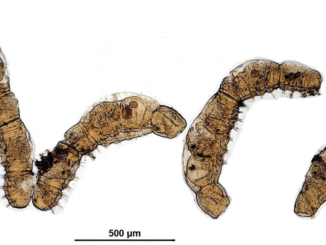
Paper category: Original research paper
Corresponding author: Katarzyna Zając (kzajac@iop.krakow.pl)
DOI: 10.1515/ohs-2018-0009
Received: 21 March 2017
Accepted: 24 July 2017
Full text: here
Citation (APA style):
Abstract
A new large population of the Asian clam Corbicula fluminea (O. F. Müller, 1774) was found within a reach (ca 210 km long) of one of the largest European rivers, the Vistula. The largest population and the largest individuals were found at the outlet of a channel collecting heated water from the cooling process at the Połaniec power station and adjacent parts of the river. In the northern part of the study area, bivalves occurred at the channel margins, in groyne fields, and in the shallows of sand banks or sandbars. The clams were less numerous in places where the river was regulated with straightened banks and stone ripraps. Twenty-five other taxa of mollusks were found altogether at the sampling stations where Corbicula was observed, including other non-indigenous mollusk species.
References
Aldridge, D.C. & Müller, S.J. (2001). The Asiatic clam, Corbicula fluminea, in Britain: current status and potential impacts. Journal of Conchology 37(2): 177–183.
Araujo, R., Moreno, D. & Ramos, M.A. (1993). The Asiatic clam Corbicula fluminea (Müller, 1774) (Bivalvia: Corbiculidae) in Europe. American Malacological Bulletin 10: 39–49.
Beaver, J.R., Crisman, T.L. & Brock, R. J. (1991). Grazing Effects of an Exotic Bivalve (Corbicula fluminea) on Hypereutrophic Lake Water. Lake and Reservoir Management 7(1): 45–51. DOI: 10.1080/07438149109354253.
Beran, L. (2000). First record of Corbicula fluminea (Mollusca: Bivalvia) in the Czech Republic. Acta Societatis Zoologicae Bohemicae 64: 1–2.
Beran, L. (2006). Spreading expansion of Corbicula fluminea (Mollusca: Bivalvia) in the Czech Republic. Heldia 6: 187–192.
Bespalaya, Y., Bolotov, I., Aksenova, O., Kondakov, A. (2016). The first records of Corbicula clams (Bivalvia Corbiculidae) in Northern European Russia: main causes and possible consequences genetic and shell morphological discrepancies. In: Abstract Book. UArctic Congress 2016, 12–16 September, St. Petersburg, Russia (p. 88). University of the Arctic/University of Oulu.
Bij de Vaate, A. (1991). Colonization of the German part of the River Rhine by the Asiatic clam, Corbicula fluminea Müller, 1774 (Pelecypoda, Corbiculidae). Bulletin Zoölogisch Museum. Universiteit van Amsterdam 13(2): 13–16.
Bij de Vaate, A. & Greijdanus-Klaas, M. (1990). The Asiatic clam, Corbicula fluminea Müller, 1774 (Pelecypoda, Corbiculidae), a new immigrant in the Netherlands. Bulletin Zoologisch Museum, Universiteit van Amsterdam 12(12): 173–178.
Bij de Vaate, A. & Hulea, O. (2000). Range extension of the Asiatic clam Corbicula fluminea (Müller 1774) in the river Danube: first record from Romania. Lauterbornia 38: 23–26.
Bódis, E. (2007). The biomass dynamics of Corbicula fluminea invasive mussel. Acta Biologica Debrecina. Supplementum Oecologica Hungarica 16: 9–20.
Bódis, E., Nosek, J., Oertel, N., Tóth, B. & Fehér, Z. (2011). A Comparative Study of Two Corbicula Morphs (Bivalvia, Corbiculidae) Inhabiting River Danube. International Review of Hydrobiology 96(3): 257–273. DOI: 10.1002/iroh.201111344.
Bódis, E., Tóth, B. & Sousa, R. (2014). Impact of Dreissena fouling on the physiological condition of native and invasive bivalves: interspecific and temporal variations. Biological Invasions 16: 1373–1386. DOI: 10.1007/s10530-013-0575-z.
Cappelletti, C., Cianfanelli, S., Beltrami, M. E. & Ciutti, F. (2009). Sinanodonta woodiana (Lea, 1834) (Bivalvia: Unionidae): a new non-indigenous species in Lake Garda (Italy). Aquatic Invasions 4: 685–688. DOI: 10.3391/ai.2009.4.4.15.
Ciutti, F. & Cappelletti, C. (2009). First record of Corbicula fluminalis (Müller, 1774) in Lake Garda (Italy), living in sympatry with Corbicula fluminea (Müller, 1774). Journal of Limnology 68(1): 162–165. DOI: 10.4081/jlimnol.2009.162.
Cebulska, K., Krodkiewska, M. (2017). The dispersion of Corbicula fluminea (O. F. Müller, 1774) (Mollusca: Corbiculidae) in the Upper Oder River (Southern Poland). In Abstracts of 8th EuroMal European Congress of Malacological Societies, 10–14 September 2017, Kraków, Poland (p. 115). Polish Malacological Society/Institute of Nature Conservation PAS.
Counts, C.L. (1981). Corbicula fluminea (Bivalvia: Corbiculidea) in British Columbia. Nautilus 95: 12–13.
Crespo, D., Dolbeth, M., Leston, S., Sousa, R. & Pardal, M.Â. (2015). Distribution of Corbicula fluminea (Müller, 1774) in the invaded range: a geographic approach with notes on species traits variability. Biological Invasions 17(7): 2087–2101. DOI: 10.1007/s10530-015-0862-y.
Csányi, B. (1998–1999). Spreading invaders along the Danubian highway: first record of Corbicula fluminea and C. fluminalis in Hungary. Folia Historico Naturalia Musei Matraensis 23: 343–345.
Domagała, J., Łabęcka, M.A., Pilecka-Rapacz, M. & Migdalska B. (2004). Corbicula fluminea (O.F. Müller, 1774) (Bivalvia, Corbiculidae) – a species new to the Polish malacofauna. Folia Malacologica 12: 145–148. DOI: 10.12657/folmal.012.011.
Elliott, P. & zu Ermgassen, P.S.E. (2008). The Asian clam (Corbicula fluminea) in the River Thames, London, England. Aquatic Invasions 3(1): 54–60. DOI: 10.3391/ai.2008.3.1.9.
Ferreira-Rodríguez, N., Fernández, C.A. & Pardo, I. (2017a). Corbicula fluminea as new food resource for native and exotic terrapins (NW Iberian Peninsula). North-Western Journal of Zoology: e171502.
Ferreira-Rodríguez, N., Sousa, R. & Pardo, I. (2017b). Negative effects of Corbicula fluminea over native freshwater mussels. Hydrobiologia. DOI: 10.1007/s10750-016-3059-1.
Francis, R.A. & Chadwick M.A. (2012). Invasive alien species in freshwater ecosystems. A brief overview. In R.A. Francis (Ed.), A Handbook of Global Freshwater Invasive Species (pp. 3–14). London, UK: Earthscan.
Gardner, J.A., Woodall, W.R., Staats, A. & Napoli, J.F. (1976). Invasion of the Asiatic clam (Corbicula manilensis Philippi) in the Altamaha River, Georgia. Nautilus 90: 117–125.
Glaubrecht, M., Fehér, Z. & Köhler, F. (2007). Inventorizing an invader: Annotated type catalogue of the freshwater clams Corbiculidae Gray, 1847 (Bivalvia, Heterodonta, Veneroidea), including old world limnic Corbicula in the Natural History Museum Berlin. Malacologia 49(2): 243–272. DOI: 10.4002/0076-2997-49.2.243.
Graczyk, T.K., Conn, D.B., Marcogliese, D.J., Graczyk, H. & de Lafontaine, Y. (2003). Accumulation of human waterborne parasites by zebra mussels (Dreissena polymorpha) and Asian freshwater clams (Corbicula fluminea). Parasitology Research 89(2): 107–112. DOI: 10.1007/s00436-002-0729-x.
Hebert, P.D.N., Wilson, C.C., Murdoch, M.H. & Lazar, R. (1991). Demography and ecological impacts of the invading mollusc Dreissena polymorpha. Canadian Journal of Zoology 69: 405–409. DOI: 10.1139/z91-063.
Horsák, M., Juřičková, L. & Picka, J. (2013). Molluscs of the Czech and Slovak Republics. Zlin: Nakladatelstvi Kabourek.
Howlett, D. & Baker, R. (1999). Corbicula fluminea (Müller): New to UK. Journal of Conchology 36: 83–83.
Hubenov, Z., Trichkova, T., Kenderov, L. & Kozuharov, D. (2013). Distribution of Corbicula fluminea (Mollusca: Corbiculidae) over an Eleven-Year Period of its Invasion in Bulgaria. Acta zoologica bulgarica 65(3): 315–326.
Ilarri, M.I. & Sousa, R. (2012). Corbicula fluminea Müller (Asian calm). In R.A. Francis (Ed.), A Handbook of Global Freshwater Invasive Species (pp. 173-183). London, UK: Earthscan.
Ituarte, C.F. (1981). Primera noticia acerca de la introduccion de pelecipodos asiaticos en el area Rioplatense (Mollusca, Corbiculidae). Neotropica 27: 79–82.
Janas, U., Kendzierska, H., Dąbrowska, A.H. & Dziubińska, A. (2014). Non-indigenous bivalve − the Atlantic rangia Rangia cuneata − in the Wisła Śmiała River (coastal waters of the Gulf of Gdańsk, the southern Baltic Sea). Oceanol. Hydrobiol. St. 43(4): 427–430. DOI: 10.2478/s13545-014-0158-3.
Kołodziejczyk, A. & Łabęcka, A.M. (2011). Corbicula fluminalis (O.F. Müller, 1774). In Z. Głowaciński, H. Okarma, J. Pawłowski & W. Solarz (Eds.), Alien species in the fauna of Poland (pp. 146–150). Kraków: IOP PAN (in Polish with English summary).
Kownacki, A. (1999). Checklist of macroinvertebrates in the River Vistula. Acta Hydrobiologica 41(1): 45–75.
Kraemer, L.R. (1979). Corbicula (Bivalvia: Sphaeriacea) vs. indigenous mussels (Bivalvia: Unionacea) in U.S. rivers. A hard case for interspecific competition? American Zoologist 19: 1085–1096. DOI: 10.1093/icb/19.4.1085.
Krebs, R.A., Barkett, E.M. & Begley, M.T. (2015). The impact of dreissenid mussels on growth of the fragile papershell (Leptodea fragilis), the most abundant unionid species in Lake Erie. Canadian Journal of Zoology 93: 143–148. DOI: 10.1139/cjz-2014-0215.
Lee, T., Siripattrawan, S., Ituarte, C. F. & O´Foighil, D. (2005). Invasion of the clonal clams: Corbicula lineages in the New World. American Malacological Bulletin 20: 113–122.
Leff, L.G., Burch, J.L. & McArthur, J.V. (1990). Spatial distribution, seston removal, and potential competitive interactions of the bivalves Corbicula fluminea and Elliptio complanata in a coastal plain stream. Freshwater Biology 24: 490–416.
Leuven, R.S.E.W., Van der Velde, G., Baijens, I., Snijders, J., Van der Zwart, C. et al. (2009). The river Rhine: a global highway for dispersal of aquatic invasive species. Biological Invasions 11: 1998–2008. DOI: 10.1007/s10530-009-9491-7.
Łabęcka, A.M., Domagała, J. & Pilecka-Rapacz, M. (2005). First record of Corbicula fluminalis (O. F. Müller, 1774) (Bivalvia: Corbiculidae) in Poland. Folia Malacologica 13(1): 25–27. DOI: 10.12657/folmal.013.003.
Maćkiewicz, J.J. (2013). The first record of the Asian clam Corbicula fluminea (Bivalvia: Veneroida: Corbiculidae) in the upper Vistula (south Poland). Folia Malacologica 21(2): 87–90. DOI: 10.12657/folmal.021.009.
Mattice, J.S., & Dye, L.L. (1976). Thermal tolerance of the adult Asiatic Clam. In G.W. Esch & R.W. McFarlane (Eds.), Thermal Ecology II, United States Energy Research and Development Association ERDA Symposium Series (CON F-750425) (pp. 130–35). Springfield, Virginia: National Technical Information Service.
McMahon, R.F. (1983). Ecology of an invasive pest bivalve, Corbicula. In: W.D. Russell-Hunter (Ed.), The Mollusca. Ecology (pp. 505–561). New York: Academic Press.
McMahon, R. F. (1999). Invasive characteristics of the freshwater bivalve Corbicula fluminea. Chapter 23. In R. Claudi & J.H. Leach (Eds.), Nonindigenous freshwater organisms. Vectors, biology, and impacts (pp. 315–343). Boca Raton, FL: Lewis Publishers.
McMahon, R.F. (2002). Evolutionary and physiological adaptations of aquatic invasive animals: r selection versus resistance. Canadian Journal of Fisheries and Aquatic Sciences 59(7): 1235–1244. DOI: 10.1139/f02-105.
Minchin, D. (2009). Corbicula fluminea (Müller), Asian clam (Corbiculidae, Mollusca). In DAISIE. Handbook of Alien Species in Europe. Chapter 13. Species Accounts of 100 of the Most Invasive Alien Species in Europe. (p. 306). Springer Netherlands. DOI: 10.1007/978-1-4020-8280-1.
Minchin, D. (2014). The distribution of the Asian clam Corbicula fluminea and its potential to spread in Ireland. Management of Biological Invasions 5(2): 165–177. DOI: 10.3391/mbi.2014.5.2.10.
Morton, B. (1986). Corbicula in Asia – an updated synthesis. American Malacological Bulletin, Special Edition: 113–124.
Mouthon, J. (1981). Sur la presence en France et au Portugal de Corbicula (Bivalvia, Corbiculidae) originaire d’Asie. Basteria 45: 109–116.
Müller, O. & Baur, B. (2011). Survival of the invasive clam Corbicula fluminea (Müller) in response to winter water temperature. Malacologia 53(2): 367–371. DOI: 10.4002/040.053.0207.
Munjiu, O. & Shubernetski, I. (2010). First record of Asian clam Corbicula fluminea (Müller, 1774) in the Republic of Moldova. Aquatic Invasions 5, Supplement 1: 67–70. DOI: 10.3391/ai.2010.5.S1.015.
Panov, V.E., Alexandrov, B., Arbaciauskas, K., Binimelis, R., Copp, G.H. et al. (2009). Assessing the Risks of Aquatic Species Invasions via European Inland Waterways: From Concepts to Environmental Indicators. Integrated Environmental Assessment and Management 5(1): 110–126. DOI: 10.1897/IEAM_2008-034.1.
Paunović, M., Csányi, B. , Knežević, S. , Simić, V. , Nedanić, D. et al. (2007). Distribution of Asian clams Corbicula fluminea (Müller, 1774) and Corbicula fluminalis (Müller, 1774) in Serbia. Aquatic Invasions 2(2): 99–106. DOI: 10.3391/ai.2007.2.2.3.
Piechocki, A. & Szlauer-Łukaszewska, A. (2013). Molluscs of the middle and lower Odra: The role of the river in the expansion of alien species in Poland. Folia Malacologica 21(2): 73–86. DOI: 10.12657/folmal.021.008.
Pigneur, L.-M., Marescaux, J., Roland, K., Etoundi, E., Descy J.-P. et al. (2011). Phylogeny and androgenesis in the invasive Corbicula clams (Bivalvia, Corbiculidae) in Western Europe. BMC Evolutionary Biology 11: 147. DOI: 10.1186/1471-2148-11-147.
Pigneur, L.-M., Etoundi, E., Aldridge, D.C., Marescaux, J., Yasuda, N. et al. (2014). Genetic uniformity and long-distance clonal dispersal in the invasive androgenetic Corbicula clams. Molecular Ecology 23(20): 5102–5116. DOI: 10.1111/mec.12912.
Ponder, W. F., Hallan, A., Shea, M. & Clark, S.A. (2016). Australian Freshwater Molluscs. http://keys.lucidcentral.org/keys/v3/freshwater_molluscs/.
Prezant, R.S. & Chalermwat, K. (1984). Flotation of the Bivalve Corbicula fluminea as a Means of Dispersal. Science 225(4669): 1491–1493. DOI: 10.1126/science.225.4669.1491.
Romanowski, J., Winczek, M. & Ceryngier, P. (2016). Stwierdzenie Corbicula fluminea (O. F. Müller, 1774) (Veneroida: Corbiculidae) w Wiśle w Warszawie. Kulon 21: 131−133.
Schmidlin, S. (2004). Muschel-Invasion im Rhein. Uni Nova 97: 30−31.
Schmidlin, S. & Baur, B. (2007). Distribution and substrate preference of the invasive clam Corbicula fluminea in the river Rhine in the region of Basel (Switzerland, Germany, France). Aquatic Sciences 69(1): 153–161. DOI: 10.1007/s00027-006-0865-y.
Schmidlin, S., Schmera, D., Ursenbacher, S. & Baur, B. (2012). Separate introductions but lack of genetic variability in the invasive clam Corbicula spp. in Swiss lakes. Aquatic Invasions 7(1): 73–80. DOI: 10.3391/ai.2012.7.1.008.
Sickel, J.B. (1986). Corbicula population mortalities: factors influencing population control. American Malacological Bulletin, Special Edition 2: 89–94.
Simard, M.A., Paquet, A., Jutras, Ch., Robitaille, Y., Blier, P.U. et al. (2012). North American range extension of the invasive Asian clam in a St. Lawrence River power station thermal plume. Aquatic Invasions 7(1): 81–89. DOI: 10.3391/ai.2012.7.1.009.
Sousa, R., Freire, R., Rufino, M., Méndez, J., Gaspar, M. et al. (2007). Genetic and shell morphological variability of the invasive bivalve Corbicula fluminea (Müller, 1774) in two Portuguese estuaries. Estuarine, Coastal and Shelf Science 74 (1-2): 166–174. DOI: 10.1016/j.ecss.2007.04.011.
Sousa, R., Antunes, C.& Guilhermino, L. (2008a). Ecology of the invasive Asian clam Corbicula fluminea (Müller, 1774) in aquatic ecosystems: an overview. Annales de Limnologie – International Journal of Limnology 44(2): 85–94. DOI: 10.1051/limn:2008017.
Sousa, R., Rufino, M., Gaspar, M., Antunes, C. & Guilhermino, L. (2008b). Abiotic impacts on spatial and temporal distribution of Corbicula fluminea (Müller, 1774) in the River Minho estuary, Portugal. Aquatic Conservation: Marine and Freshwater Ecosystems 18(1): 98–110. DOI: 10.1002/aqc.838.
Sousa, R, Gutiérrez, J.L. & Aldridge, D.C. (2009). Non-indigenous invasive bivalves as ecosystem engineers. Biological Invasions 11(10): 2367–2385. DOI: 10.1007/s10530-009-9422-7.
Sousa, R., Pilotto, F. & Aldridge D.C. (2011). Fouling of European freshwater bivalves (Unionidae) by the invasive zebra mussel (Dreissena polymorpha). Freshwater Biology 56: 867–876.
Sousa, R., Novais, A., Costa, R. & Strayer, D. (2014). Invasive bivalves in fresh waters: impacts from individuals to ecosystems and possible control strategies. Hydrobiologia 735: 233–251.
Spyra, A., Kubicka, J. & Strzelec, M. (2015). The Influence of the Disturbed Continuity of the River and the Invasive Species — Potamopyrgus antipodarum (Gray, 1843), Gammarus tigrinus (Sexton, 1939) on Benthos Fauna: A Case Study on Urban Area in the River Ruda (Poland). Environmental Management 56: 233–244. DOI: 10.1007/s00267-015-0483-3.
Stańczykowska, A. & Kołodziejczyk, A. (2011). Corbicula fluminea (O.F. Müller, 1774). In Z. Głowaciński, H. Okarma, J. Pawłowski & W. Solarz (Eds.), Alien species in the fauna of Poland (pp: 151–156). Kraków: IOP PAN (In Polish with English summary).
Strayer, D.L. (1999). Effects of alien species on freshwater molluscs in North America. Journal of North American Benthological Society 18(1): 74–98. DOI: 10.2307/1468010.
Tittizer, T. & Taxacher, M. (1997). Erstnachweis von Corbicula fluminea/fluminalis (Müller, 1774) (Corbiculidae, Mollusca) in the River Danube. Lauterbornia 31: 103–107.
Warzocha, J. & Drgas, A. (2013). The Alien Gulf Wedge Clam (Rangia cuneata G. B. Sowerby I, 1831) (Mollusca: Bivalvia: Mactridae) in the Polish Part of the Vistula Lagoon (SE Baltic). Folia Malacologica 21(4): 291–292. DOI: 10.12657/folmal.021.030.
Wawrzyniak-Wydrowska, B. (2007). Preliminary studies on the occurrence of the Asiatic clam Corbicula fluminea (O. F. Müller, 1774) (Bivalvia: Corbiculidae) in River Odra (Poland). In World Congress of Malacology, 15020 July 2007 (pp. 238–239). Antwerp, Belgium: Unitas Malacologica.
Weitere, M., Vohmann, A., Schulz, N., Linn, C., Dietrich, D. et al. (2009). Linking environmental warming to the fitness of the invasive clam Corbicula fluminea. Global Change Biology 15(12): 2838–2851. DOI: 10.1111/j.1365-2486.2009.01925.x.
Vrabec, V., Čejka, T., Šporka, F., Hamerlík, L. & Král, D. (2003). First record of Corbicula fluminea (Mollusca, Bivalvia) from Slovakia with a note about its dispersion in Central Europe. Biologia 58(5): 942–952.
Yanygina, L.V. ( 2017). Pathways of macroinvertebrate invasions in the Ob River basin (West Siberia). Limnology 18(2): 243–249.
Yeager, M.M., Neves, R.J. & Cherry, D.S. (1999). Competitive interactions between early life stages of Villosa iris (Bivalvia: Unionidae) and adult Asian clams (Corbicula fluminea). In P.D. Johnson & R.S. Butler (Eds.), Freshwater Mollusk Symposium Proceedings – Part II: Proceedings of the First Freshwater Mollusk Conservation Society Symposium, March, 1999. (pp. 253–259). Columbus, Ohio: Ohio Biological Survey.
Zukowski, S. & Walker, K.F. (2009). Freshwater snails in competition: alien Physa acuta (Physidae) and native Glyptophysa gibbosa (Planorbidae) in the River Murray, South Australia. Marine and Freshwater Research 60: 999–1005. DOI: 10.1071/MF08183.
Zając, K. (2014). Size-dependent predation by otter Lutra lutra on swan mussels Anodonta cygnea (Linnaeus 1758) – observations and radiotelemetry experiment. Journal of Conchology 41: 559–563.



Bądź pierwszy, który skomentuje ten wpis